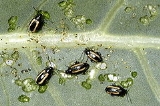
Flea beetle
Encyclopedia
Flea beetles is a general name applied to the small, jumping beetle
s of the leaf beetle
family
(Chrysomelidae). They make up the tribe
Alticini, which is a part of the subfamily Galerucinae
, though they were historically classified as a subfamily in their own right. Though most tribes of the Galerucinae are suspect of rampant paraphyly
in the present delimitation, the Alticini seem to form a good clade
at least for the most part.
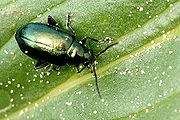 The adults are very small to moderately sized Chrysomelidae (i.e. among beetles in general they are on the smallish side). They are similar to other leaf beetles, but characteristically have the hindleg femora
The adults are very small to moderately sized Chrysomelidae (i.e. among beetles in general they are on the smallish side). They are similar to other leaf beetles, but characteristically have the hindleg femora
greatly enlarged. These enlarged femora allow for the springing action of these insects when disturbed. Flea beetles can also walk normally and fly. Many flea beetles are attractively coloured; dark, shiny and often metallic colors predominate.
Adult flea beetles feed externally on plants, eating the surface of the leaves, stems and petals. Under heavy feeding the small round holes caused by an individual flea beetle's feeding may coalesce into larger areas of damage. Some flea beetle larva
e (e.g. of Phyllotreta species) are root feeders.
In adverse weather conditions (rain, for example) some flea beetles seek shelter in the soil. Some species, such as Phyllotreta cruciferae and P. striolata, prefer to leave their hideouts only during warm and dry weather. The German name Erdflöhe (literally "earth flea
s") refers to their jumping ability and this behavior of hiding in the soil.
such as mustard
and rapeseed
(particularly canola
in north western North America). Numerous garden plants are also subject to flea beetle feeding, such as flowers of Gardenia
and Rothmannia
by Altica
species.
Other flea beetle species are beneficial, feeding on weed
s and similar nuisance plants. A few species have even been introduced to various locations as biological control agents against some weeds. One important example is in the control of Leafy Spurge
(Euphorbia esula), an invasive
weed in the United States. It has a toxic latex
and is generally avoided by herbivore
s. Flea beetles of the genus Aphthona
have been successfully introduced to control this plant.
and might include genera placed elsewhere in other sources.
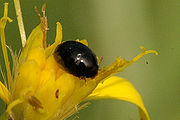
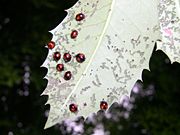
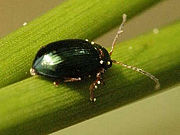
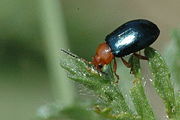
Beetle
Coleoptera is an order of insects commonly called beetles. The word "coleoptera" is from the Greek , koleos, "sheath"; and , pteron, "wing", thus "sheathed wing". Coleoptera contains more species than any other order, constituting almost 25% of all known life-forms...
s of the leaf beetle
Leaf beetle
Beetles in the family Chrysomelidae are commonly known as leaf beetles. This is a family of over 35,000 species in more than 2,500 genera, one of the largest and most commonly encountered of all beetle families....
family
Family (biology)
In biological classification, family is* a taxonomic rank. Other well-known ranks are life, domain, kingdom, phylum, class, order, genus, and species, with family fitting between order and genus. As for the other well-known ranks, there is the option of an immediately lower rank, indicated by the...
(Chrysomelidae). They make up the tribe
Tribe (biology)
In biology, a tribe is a taxonomic rank between family and genus. It is sometimes subdivided into subtribes.Some examples include the tribes: Canini, Acalypheae, Hominini, Bombini, and Antidesmeae.-See also:* Biological classification* Rank...
Alticini, which is a part of the subfamily Galerucinae
Galerucinae
The Galerucinae are a large subfamily of the leaf beetles , containing about 5800 species. It includes the flea beetles in tribe Alticini....
, though they were historically classified as a subfamily in their own right. Though most tribes of the Galerucinae are suspect of rampant paraphyly
Paraphyly
A group of taxa is said to be paraphyletic if the group consists of all the descendants of a hypothetical closest common ancestor minus one or more monophyletic groups of descendants...
in the present delimitation, the Alticini seem to form a good clade
Clade
A clade is a group consisting of a species and all its descendants. In the terms of biological systematics, a clade is a single "branch" on the "tree of life". The idea that such a "natural group" of organisms should be grouped together and given a taxonomic name is central to biological...
at least for the most part.
Description and ecology

Arthropod leg
The arthropod leg is a form of jointed appendage of arthropods, usually used for walking. Many of the terms used for arthropod leg segments are of Latin origin, and may be confused with terms for bones: coxa , trochanter , femur, tibia, tarsus, ischium, metatarsus, carpus, dactylus ,...
greatly enlarged. These enlarged femora allow for the springing action of these insects when disturbed. Flea beetles can also walk normally and fly. Many flea beetles are attractively coloured; dark, shiny and often metallic colors predominate.
Adult flea beetles feed externally on plants, eating the surface of the leaves, stems and petals. Under heavy feeding the small round holes caused by an individual flea beetle's feeding may coalesce into larger areas of damage. Some flea beetle larva
Larva
A larva is a distinct juvenile form many animals undergo before metamorphosis into adults. Animals with indirect development such as insects, amphibians, or cnidarians typically have a larval phase of their life cycle...
e (e.g. of Phyllotreta species) are root feeders.
In adverse weather conditions (rain, for example) some flea beetles seek shelter in the soil. Some species, such as Phyllotreta cruciferae and P. striolata, prefer to leave their hideouts only during warm and dry weather. The German name Erdflöhe (literally "earth flea
Flea
Flea is the common name for insects of the order Siphonaptera which are wingless insects with mouthparts adapted for piercing skin and sucking blood...
s") refers to their jumping ability and this behavior of hiding in the soil.
Relationship with humans
Flea beetles may be beneficial or may be pests, depending on the species. Many major agricultural crops are attacked by flea beetles, including various cruciferous plantsBrassicaceae
Brassicaceae, a medium sized and economically important family of flowering plants , are informally known as the mustards, mustard flowers, the crucifers or the cabbage family....
such as mustard
Mustard plant
Mustards are several plant species in the genera Brassica and Sinapis whose small mustard seeds are used as a spice and, by grinding and mixing them with water, vinegar or other liquids, are turned into the condiment known as mustard or prepared mustard...
and rapeseed
Rapeseed
Rapeseed , also known as rape, oilseed rape, rapa, rappi, rapaseed is a bright yellow flowering member of the family Brassicaceae...
(particularly canola
Canola
Canola refers to a cultivar of either Rapeseed or Field Mustard . Its seeds are used to produce edible oil suitable for consumption by humans and livestock. The oil is also suitable for use as biodiesel.Originally, Canola was bred naturally from rapeseed in Canada by Keith Downey and Baldur R...
in north western North America). Numerous garden plants are also subject to flea beetle feeding, such as flowers of Gardenia
Gardenia
Gardenia is a genus of 142 species of flowering plants in the coffee family, Rubiaceae, native to the tropical and subtropical regions of Africa, southern Asia, Australasia and Oceania....
and Rothmannia
Rothmannia
Rothmannia is a genus of plant in family Rubiaceae. The following incomplete list shows some of the species:* Rothmannia annae Keay* Rothmannia attopevensis* Rothmannia capensis Thunb....
by Altica
Altica
Altica is a large genus of flea beetles in the subfamily Galerucinae, with about 300 species, distributed nearly worldwide. The genus is best represented in the Neotropic region, well represented in the Nearctic and Palearctic, but occurs also in the Afrotropic, Indomalaya and Australasia...
species.
Other flea beetle species are beneficial, feeding on weed
Weed
A weed in a general sense is a plant that is considered by the user of the term to be a nuisance, and normally applied to unwanted plants in human-controlled settings, especially farm fields and gardens, but also lawns, parks, woods, and other areas. More specifically, the term is often used to...
s and similar nuisance plants. A few species have even been introduced to various locations as biological control agents against some weeds. One important example is in the control of Leafy Spurge
Leafy spurge
Euphorbia esula, commonly known as the Green Spurge or Leafy Spurge, is a species of spurge native to central and southern Europe , and eastward through most of Asia north of the Himalaya to Korea and eastern Siberia.It is a herbaceous perennial plant growing to 1-1.2 m tall, with several stems...
(Euphorbia esula), an invasive
Invasive species
"Invasive species", or invasive exotics, is a nomenclature term and categorization phrase used for flora and fauna, and for specific restoration-preservation processes in native habitats, with several definitions....
weed in the United States. It has a toxic latex
Latex
Latex is the stable dispersion of polymer microparticles in an aqueous medium. Latexes may be natural or synthetic.Latex as found in nature is a milky fluid found in 10% of all flowering plants . It is a complex emulsion consisting of proteins, alkaloids, starches, sugars, oils, tannins, resins,...
and is generally avoided by herbivore
Herbivore
Herbivores are organisms that are anatomically and physiologically adapted to eat plant-based foods. Herbivory is a form of consumption in which an organism principally eats autotrophs such as plants, algae and photosynthesizing bacteria. More generally, organisms that feed on autotrophs in...
s. Flea beetles of the genus Aphthona
Aphthona
Aphthona is a genus of beetle, in the leaf beetle family Chrysomelidae, native to Europe and Asia. More specifically, Aphthona are flea beetles, meaning they have enlarged hind legs for jumping away from potential danger....
have been successfully introduced to control this plant.
Selected genera
This genus list is not complete. It is also partially from ITISItis
Itis may refer to* Integrated Taxonomic Information System, a partnership designed to provide consistent and reliable information on the taxonomy of biological species...
and might include genera placed elsewhere in other sources.




- Acallepitrix J.Bechyné, 1956
- Acrocyum Jacoby, 1885
- Afroaltica
- Agasicles Jacoby, 1904
- AlticaAlticaAltica is a large genus of flea beetles in the subfamily Galerucinae, with about 300 species, distributed nearly worldwide. The genus is best represented in the Neotropic region, well represented in the Nearctic and Palearctic, but occurs also in the Afrotropic, Indomalaya and Australasia...
Geoffroy, 1762 - Anthobiodes
- AphthonaAphthonaAphthona is a genus of beetle, in the leaf beetle family Chrysomelidae, native to Europe and Asia. More specifically, Aphthona are flea beetles, meaning they have enlarged hind legs for jumping away from potential danger....
- Apteropeda
- Argopistes Motschulsky, 1860
- Argopus
- Arrhenocoela
- Asiorestia
- Asphaera Duponchel & Chevrolat, 1842
- Batophila
- Blepharida Chevrolat in Dejean, 1836
- Capraita J.Bechyné, 1957
- Cerataltica Crotch, 1873
- Chaetocnema Stephens, 1831
- Crepidodera Chevrolat in Dejean, 1836
- Derocrepis Weise, 1886
- Dibolia Latreille, 1829
- Disonycha Chevrolat in Dejean, 1836
- Distigmoptera Blake, 1943
- Dysphenges Horn, 1894
- Epitrix Foudras in Mulsant, 1859
- Glenidion H.Clark, 1860
- Glyptina J.L.LeConte, 1859
- Hemiglyptus Horn, 1889
- Hemiphrynus Horn, 1889
- Hermaeophaga
- Heyrovskya
- Hippuriphila Foudras in Mulsant, 1859
- Hornaltica Barber, 1941
- Kashmirobia
- Kuschelina J.Bechyné, 1951
- Lanka
- LongitarsusLongitarsusLongitarsus is a genus of beetles in the family Chrysomelidae. It is the most speciose genus of flea beetles, comprising over 700 species, and has a cosmopolitan distribution....
Berthold, 1827 - Luperaltica Crotch, 1873
- Luprea Jacoby, 1885
- Lysathia J.Bechyné, 1957
- Lythraria
- ManturaManturaThe mantura , is a Greek wind musical instrument with Cretan origin. It has 4 to 6 holes for the fingers and produces sound with the help of the tongue. Mantura is very widespread in Crete and Greek islands.-References:**...
Stephens, 1831 - Margaridisa J.Bechyné, 1958
- Minota
- Mniophila
- Mniophilosoma
- Monomacra Chevrolat in Dejean, 1836
- Neocrepidodera Heikertinger, 1911
- Nesaecrepida Blake, 1964
- Ochrosis
- Oedionychus
- Omophoita Chevrolat in Dejean, 1836
- Orestia
- Orthaltica Crotch, 1873
- Pachyonychis H.Clark, 1860
- Pachyonychus F.E.Melsheimer, 1847
- Parchicola J.Bechyné and B.Springlová de Bechyné, 1975
- Phydanis Horn, 1889
- Phyllotreta Chevrolat in Dejean, 1836
- Podagrica
- Pseudodibolia Jacoby, 1891
- Pseudolampis Horn, 1889
- Pseudorthygia Csiki in Heikertinger and Csiki, 1940
- Psylliodes Berthold, 1827
- Sphareoderma
- Strabala Chevrolat in Dejean, 1836
- Syphrea Baly, 1876
- Systena Chevrolat in Dejean, 1836
- Trichaltica Harold, 1876
External links
- Flea beetle description at Kansas State
- Flea Beetles, Kansas State University, July 2008
- The Handbook of Palearctic Flea Beetles - identification of PalearcticPalearcticThe Palearctic or Palaearctic is one of the eight ecozones dividing the Earth's surface.Physically, the Palearctic is the largest ecozone...
flea beetle genera, along with morphology, host plant information, and literature references - "Flea Beetles" by W.S. Cranshaw, Colorado State University Extension entomologist and professor

